Easily Applicable Superhydrophobic Composite Coating with Improved Corrosion Resistance and Delayed Icing Properties
Abstract
:1. Introduction
2. Experimental Section
2.1. Materials and Reagents
2.2. Collection of Candle Soot (CS) Particles
2.3. Fabrication of Superhydrophobic Coating
2.4. Characterizations of Wettability, Morphology, and Chemical Composition
2.5. Electrochemical Measurements
2.6. Anti-Icing Tests
3. Results and Discussion
3.1. Surface Wettability
3.2. Morphologies and Chemical Compositions
3.3. Anti-Corrosion Performance
3.4. Delayed Icing and Substrate Adaptability
4. Conclusions
Author Contributions
Funding
Institutional Review Board Statement
Data Availability Statement
Acknowledgments
Conflicts of Interest
References
- Kotadia, H.R.; Gibbons, G.; Das, A.; Howes, P.D. A review of Laser Powder Bed Fusion Additive Manufacturing of aluminium alloys: Microstructure and properties. Addit. Manuf. 2021, 46, 102155. [Google Scholar] [CrossRef]
- Kabirian, F.; Khan, A.S.; Pandey, A. Negative to positive strain rate sensitivity in 5xxx series aluminum alloys: Experiment and constitutive modeling. Int. J. Plast. 2014, 55, 232–246. [Google Scholar] [CrossRef]
- Dalili, N.; Edrisy, A.; Carriveau, R. A review of surface engineering issues critical to wind turbine performance. Renew. Sustain. Energy Rev. 2009, 13, 428–438. [Google Scholar] [CrossRef]
- Madi, E.; Pope, K.; Huang, W.; Iqbal, T. A review of integrating ice detection and mitigation for wind turbine blades. Renew. Sustain. Energy Rev. 2019, 103, 269–281. [Google Scholar] [CrossRef]
- Zheng, Q.; Wu, J.; Jiang, H.; Zhang, L.; Zhao, J.; He, J. Effect of micro-alloying element La on corrosion behavior of Al-Mg-Si alloys. Corros. Sci. 2021, 179, 109113. [Google Scholar] [CrossRef]
- Scully, J.R.; Inman, S.B.; Gerard, A.Y.; Taylor, C.D.; Windl, W.; Schreiber, D.K.; Lu, P.; Saal, J.E.; Frankel, G.S. Controlling the corrosion resistance of multi-principal element alloys. Scr. Mater. 2020, 188, 96–101. [Google Scholar] [CrossRef]
- Zhu, Q.; Zhang, B.; Zhao, X.; Wang, B. Binary Additives Enhance Micro Arc Oxidation Coating on 6061Al Alloy with Improved Anti-Corrosion Property. Coatings 2020, 10, 128. [Google Scholar] [CrossRef]
- Xi, K.; Wu, H.; Zhou, C.; Qi, Z.; Yang, K.; Fu, R.K.Y.; Xiao, S.; Wu, G.; Ding, K.; Chen, G.; et al. Improved corrosion and wear resistance of micro-arc oxidation coatings on the 2024 aluminum alloy by incorporation of quasi-two-dimensional sericite microplates. Appl. Surf. Sci. 2022, 585, 152693. [Google Scholar] [CrossRef]
- Dagdag, O.; Berisha, A.; Mehmeti, V.; Haldhar, R.; Berdimurodov, E.; Hamed, O.; Jodeh, S.; Lgaz, H.; Sherif, E.S.M.; Ebenso, E.E. Epoxy coating as effective anti-corrosive polymeric material for aluminum alloys: Formulation, electrochemical and computational approaches. J. Mol. Liq. 2022, 346, 117886. [Google Scholar] [CrossRef]
- Gao, Y.; Xiao, S.; Wu, H.; Wu, C.; Chen, G.; Yin, Y.; Chu, P.K. Effect of h-BN nanoparticles incorporation on the anti-corrosion and anti-wear properties of micro-arc oxidation coatings on 2024 aluminum alloy. Ceram. Int. 2023, 49, 37475–37485. [Google Scholar] [CrossRef]
- Song, Y.; Li, S.; Zhang, S. Peridynamic modeling and simulation of thermo-mechanical de-icing process with modified ice failure criterion. Def. Technol. 2021, 17, 15–35. [Google Scholar] [CrossRef]
- Tamer, O.; Kyriazis, A.; Sinapius, M. Parameter study and experimental analysis of a thermo-mechanical de-icing concept. Smart Mater. Struct. 2020, 29, 045021. [Google Scholar] [CrossRef]
- Shiverskii, A.V.; Owais, M.; Mahato, B.; Abaimov, S.G. Electrical Heaters for Anti/De-Icing of Polymer Structures. Polymers 2023, 15, 1573. [Google Scholar] [CrossRef] [PubMed]
- Wang, S.; Chang, S.; Qi, H.; Zhao, H. Experimental study of icing and deicing situations of different wettability surfaces composite electric heating. Appl. Therm. Eng. 2024, 238, 122045. [Google Scholar] [CrossRef]
- Gruber, M.R.; Hofko, B.; Hoffmann, M.; Stinglmayr, D.; Seifried, T.M.; Grothe, H. Deicing performance of common deicing agents for winter maintenance with and without corrosion-inhibiting substances. Cold Reg. Sci. Technol. 2023, 208, 103795. [Google Scholar] [CrossRef]
- Cherubin, A.; Guerra, J.; Barrado, E.; Serrada, C.G.; Pulido, F.J. Addition of amines to molasses and lees as corrosion inhibitors in sustainable de-icing materials. Sustain. Chem. Pharm. 2022, 29, 100789. [Google Scholar] [CrossRef]
- Marmur, A. The Lotus Effect: Superhydrophobicity and Metastability. Langmuir 2004, 20, 3517–3519. [Google Scholar] [CrossRef]
- Su, Y.; Ji, B.; Huang, Y.; Hwang, K. Nature’s Design of Hierarchical Superhydrophobic Surfaces of a Water Strider for Low Adhesion and Low-Energy Dissipation. Langmuir 2010, 26, 18926–18937. [Google Scholar] [CrossRef]
- Liu, J.; Zhang, X.; Wang, R.; Long, F.; Zhao, P.; Liu, L. A mosquito-eye-like superhydrophobic coating with super robustness against abrasion. Mater. Des. 2021, 203, 109552. [Google Scholar] [CrossRef]
- Zhang, B.; Yan, J.; Xu, W.; Zhang, Y.; Duan, J.; Hou, B. Robust, scalable and fluorine-free superhydrophobic anti-corrosion coating with shielding functions in marine submerged and atmospheric zones. Mater. Des. 2022, 223, 111246. [Google Scholar] [CrossRef]
- Lei, Y.; Jiang, B.; Liu, H.; Zhang, F.; An, Y.; Zhang, Y.; Yuan, Y.; Xu, J.; Li, X.; Liu, T. Mechanically robust superhydrophobic polyurethane coating for anti-icing application. Prog. Org. Coat. 2023, 183, 107795. [Google Scholar] [CrossRef]
- Saleem, J.; Moghal, Z.K.B.; McKay, G. Transforming polypropylene waste into transparent anti-corrosion weather-resistant and anti-bacterial superhydrophobic films. J. Hazard. Mater. 2024, 466, 133597. [Google Scholar] [CrossRef] [PubMed]
- Zhang, B.; Xue, X.; Zhao, L.; Hou, B. Transparent Superhydrophobic and Self-Cleaning Coating. Polymers 2024, 16, 1876. [Google Scholar] [CrossRef] [PubMed]
- Liravi, M.; Pakzad, H.; Moosavi, A.; Borujerdi, A.N. A comprehensive review on recent advances in superhydrophobic surfaces and their applications for drag reduction. Prog. Org. Coat. 2020, 140, 105537. [Google Scholar] [CrossRef]
- Thabit, N.Y.A.; Uwaezuoke, O.J.; Elella, M.H.A. Superhydrophobic nanohybrid sponges for separation of oil/ water mixtures. Chemosphere 2022, 294, 133644. [Google Scholar] [CrossRef]
- Jung, S.; Woo, S.; Heo, D.; Park, S.; Cho, S.; Choi, M.; Cho, Y.; Lee, S.; Hong, J. Droplet-based energy harvesting superhydrophobic membrane with bacterial sensing ability for continuous monitoring. Chem. Eng. J. 2023, 457, 141066. [Google Scholar] [CrossRef]
- Chu, L.; Li, W.; Zhan, Y.; Amirfazli, A. Magnetically Responsive Superhydrophobic Surfaces with Droplet Manipulation Capability. Adv. Eng. Mater. 2023, 25, 2201352. [Google Scholar] [CrossRef]
- Jia, L.; Zhou, C.; Dai, K.; Yan, D.; Li, Z. Facile fabrication of highly durable superhydrophobic strain sensors for subtle human motion detection. J. Mater. Sci. Technol. 2022, 110, 35–42. [Google Scholar] [CrossRef]
- Zhu, G.; Su, J.; Yin, C.; Li, H.; Yao, Y.; Zhang, L.; Yao, X.; Zhang, X.; Liu, F. Constructing a robust ZIF-7 based superhydrophobic coating with the excellent performance in self-cleaning, anti-icing, anti-biofouling and anti-corrosion. Appl. Surf. Sci. 2023, 622, 156907. [Google Scholar] [CrossRef]
- Shu, Y.; Lu, X.; Lu, W.; Su, W.; Wu, Y.; Wei, H.; Xu, D.; Liang, J.; Xie, Y. Mechanically robust superhydrophobic copper surface with self-cleaning, anti-icing, and corrosion resistance. Surf. Coat. Technol. 2023, 455, 129216. [Google Scholar] [CrossRef]
- Han, J.; Liu, E.; Zhou, Y.; Zhao, S.; Yan, H.; Hu, C.; Kang, J.; Han, Q.; Su, Y. Robust superhydrophobic film on aluminum alloy prepared with TiO2/SiO2-silane composite film for efficient self-cleaning, anti-corrosion and anti-icing. Mater. Today Commun. 2023, 34, 105085. [Google Scholar] [CrossRef]
- Zhang, B.; Qiao, M.; Xu, W.; Hou, B. All-organic superhydrophobic coating with anti-corrosion, anti-icing capabilities and prospective marine atmospheric salt-deliquesce self-coalesce protective mechanism. J. Ind. Eng. Chem. 2022, 115, 430–439. [Google Scholar] [CrossRef]
- Zhang, B.; Xu, W.; Xia, D.; Fan, X.; Duan, J.; Lu, Y. Comparison Study of Self-Cleaning, Anti-Icing, and Durable Corrosion Resistance of Superhydrophobic and Lubricant-Infused Ultraslippery Surfaces. Langmuir 2021, 37, 11061–11071. [Google Scholar] [CrossRef] [PubMed]
- Zhang, B.; Yang, G.; Xu, W.; Duan, J.; Hou, B. Hybrid superamphiphobic anti-corrosion coating with integrated functionalities of liquid repellency, self-cleaning, and anti-icing. J. Mater. Sci. Technol. 2024, 184, 256–268. [Google Scholar] [CrossRef]
- Zhang, B.; Liu, X.; Zhan, T.; Hou, B. Bilayer coating fabricated on aluminum alloy substrates with superamphiphobicity, corrosion resistance, self-cleaning, and delayed icing properties. J. Mater. Res. Technol. 2024, 30, 8218–8227. [Google Scholar] [CrossRef]
- Zhang, B.; Yang, G.; Fan, X.; Wang, X.; Hou, B. Intermediate-layer strengthened superhydrophobic coating with stable corrosion resistance, delayed icing and long-term weatherability. J. Ind. Eng. Chem. 2023, 127, 331–342. [Google Scholar] [CrossRef]
- Vashishth, P.; Bairagi, H.; Narang, R.; Shukla, S.K.; Mangla, B. Thermodynamic and electrochemical investigation of inhibition efficiency of green corrosion inhibitor and its comparison with synthetic dyes on MS in acidic medium. J. Mol. Liq. 2022, 365, 120042. [Google Scholar] [CrossRef]
- Sow, P.K.; Singhal, R.; Sahoo, P.; Radhakanth, S. Fabricating low-cost, robust superhydrophobic coatings with re-entrant topology for self-cleaning, corrosion inhibition, and oil-water separation. J. Colloid Interface Sci. 2021, 600, 358–372. [Google Scholar] [CrossRef]
- Zhi, J.; Wang, S.; Zhang, J.; Duan, X.; Wang, J. Unveiling the Relationship of Surface Roughness on Superliquid-Repelling Properties with Randomly Distributed Rough Surface Structures. Langmuir 2022, 38, 12841–12848. [Google Scholar] [CrossRef]
- He, Y.; Wang, L.; Wu, T.; Wu, Z.; Chen, Y.; Yin, K. Facile fabrication of hierarchical textures for substrate-independent and durable superhydrophobic surfaces. Nanoscale 2022, 14, 9392–9400. [Google Scholar] [CrossRef]
- Nayak, S.R.; Mohana, K.N.S.; Hegde, M.B.; Rajitha, K.; Madhusudhana, A.M.; Naik, S.R. Functionalized multi-walled carbon nanotube/polyindole incorporated epoxy: An effective anti-corrosion coating material for mild steel. J. Alloys Compd. 2021, 856, 158057. [Google Scholar] [CrossRef]
- Singh, A.; Ansari, K.R.; Chauhan, D.S.; Quraishi, M.A.; Kaya, S. Anti-corrosion investigation of pyrimidine derivatives as green and sustainable corrosion inhibitor for N80 steel in highly corrosive environment: Experimental and AFM/XPS study. Sustain. Chem. Pharm. 2020, 16, 100257. [Google Scholar] [CrossRef]
- Keyvani, A.; Kamkar, N.; Chaharmahali, R.; Bahamirian, M.; Kaseem, M.; Fattah-alhosseini, A. Improving anti-corrosion properties AZ31 Mg alloy corrosion behavior in a simulated body fluid using plasma electrolytic oxidation coating containing hydroxyapatite nanoparticles. Inorg. Chem. Commun. 2023, 158, 111470. [Google Scholar] [CrossRef]
- Kamde, M.A.; Mahton, Y.; Saha, P. A stearic acid/polypyrrole-based superhydrophobic coating on squeeze-cast Mg-Sr-Y-Ca-Zn alloys for improved salt-water corrosion. Surf. Coat. Technol. 2022, 448, 128890. [Google Scholar] [CrossRef]
- Roshan, S.; Sarabi, A.A.; Jafari, R.; Momen, G. One-step fabrication of superhydrophobic nanocomposite with superior anticorrosion performance. Prog. Org. Coat. 2022, 169, 106918. [Google Scholar] [CrossRef]
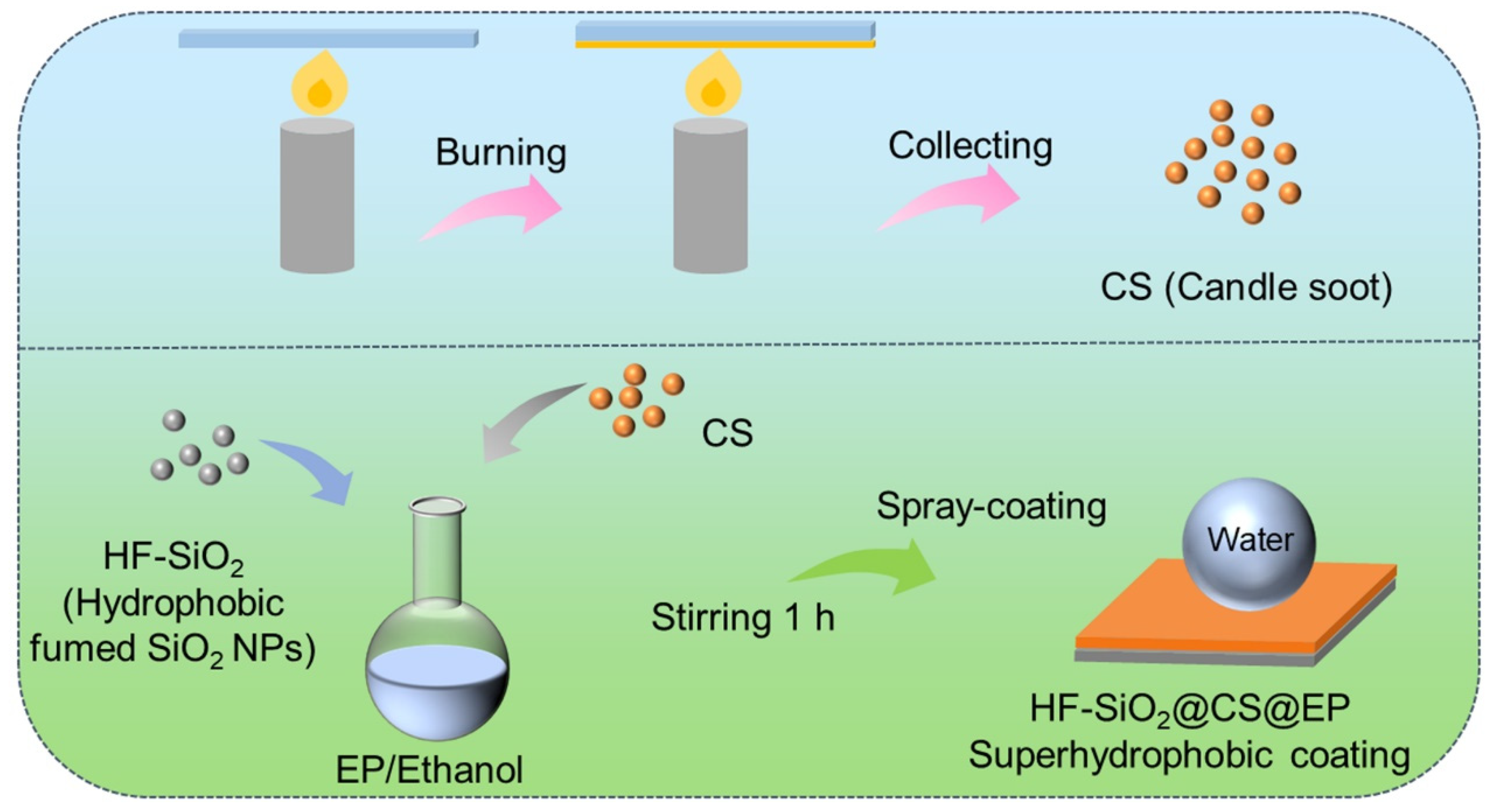
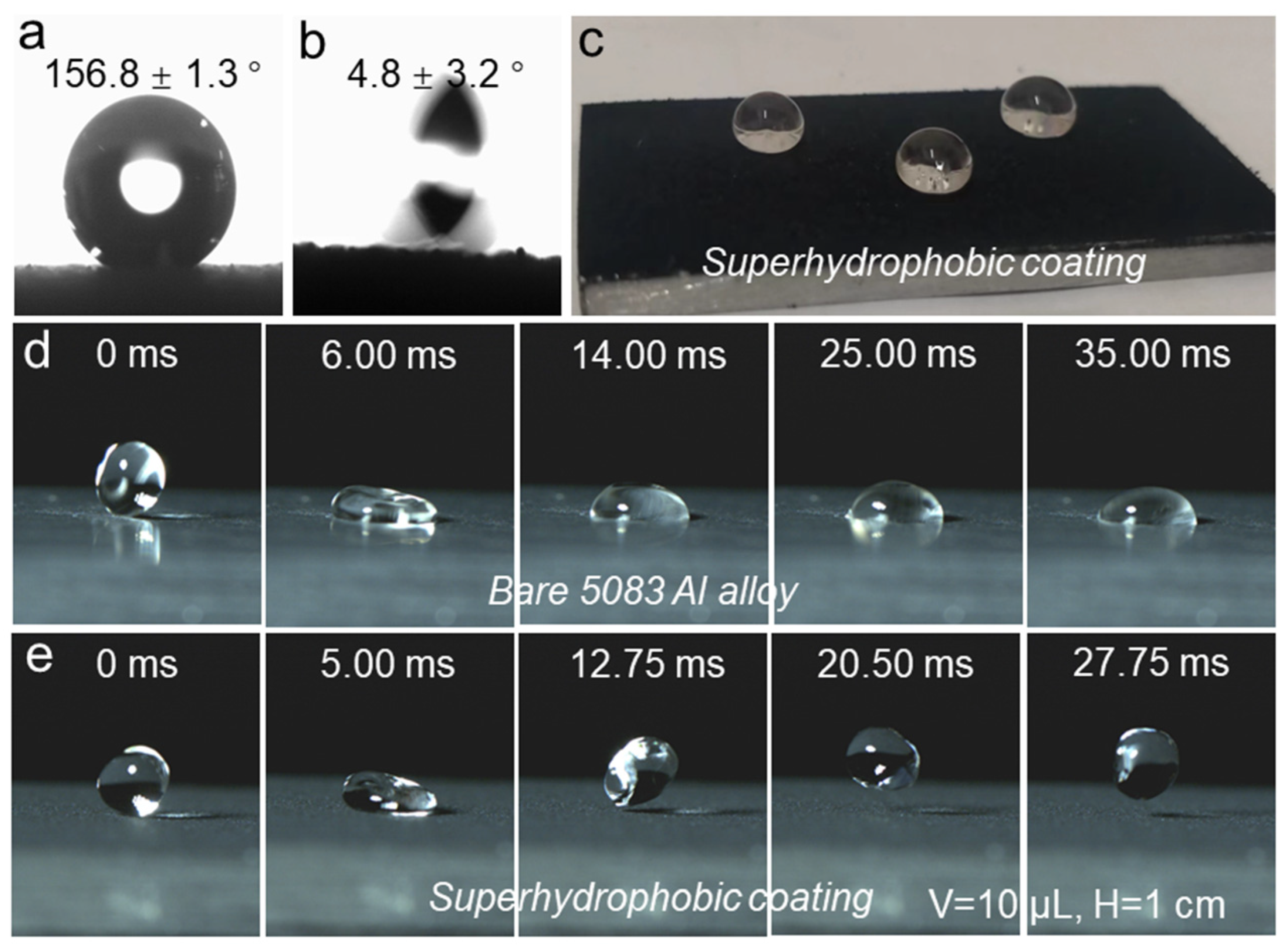
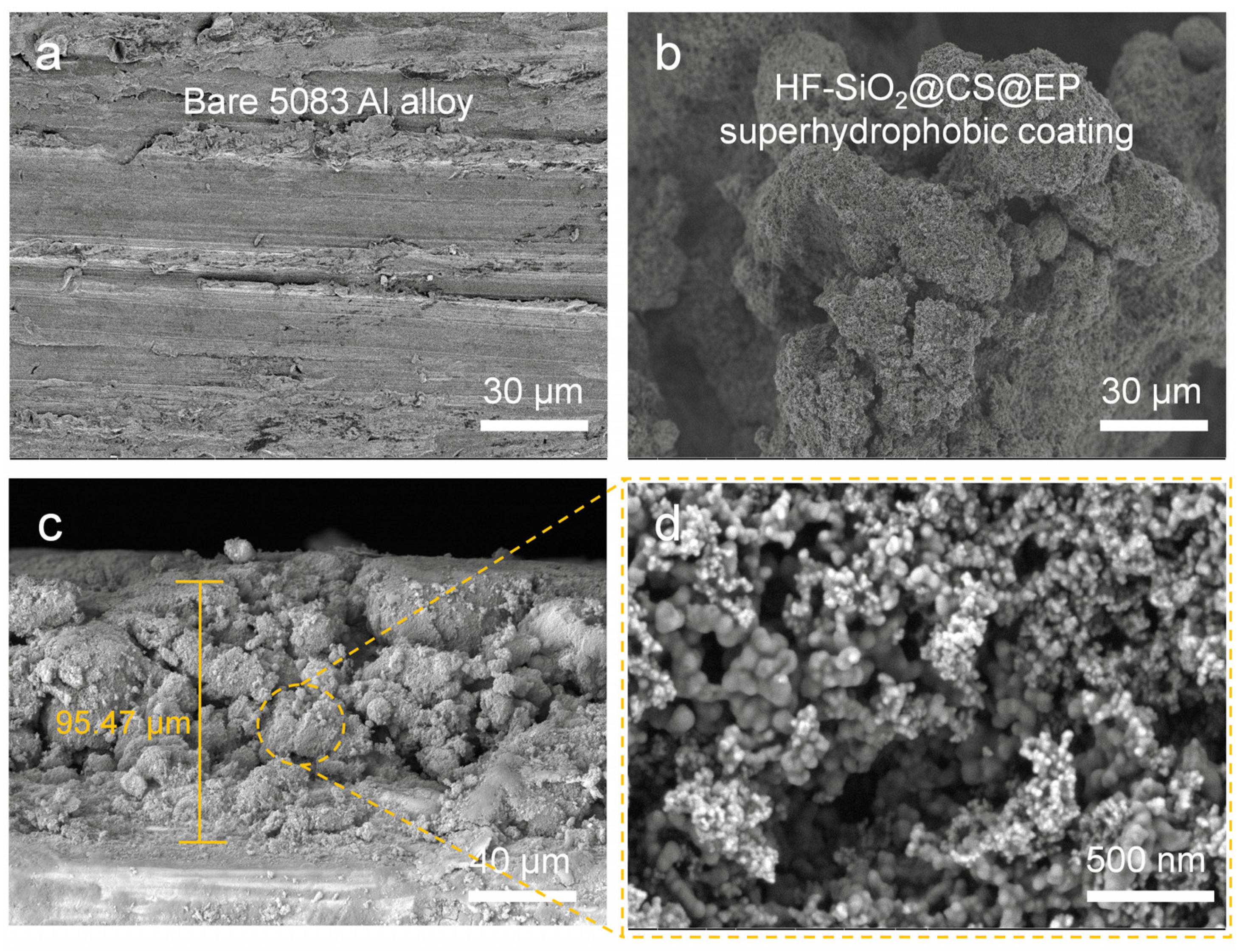

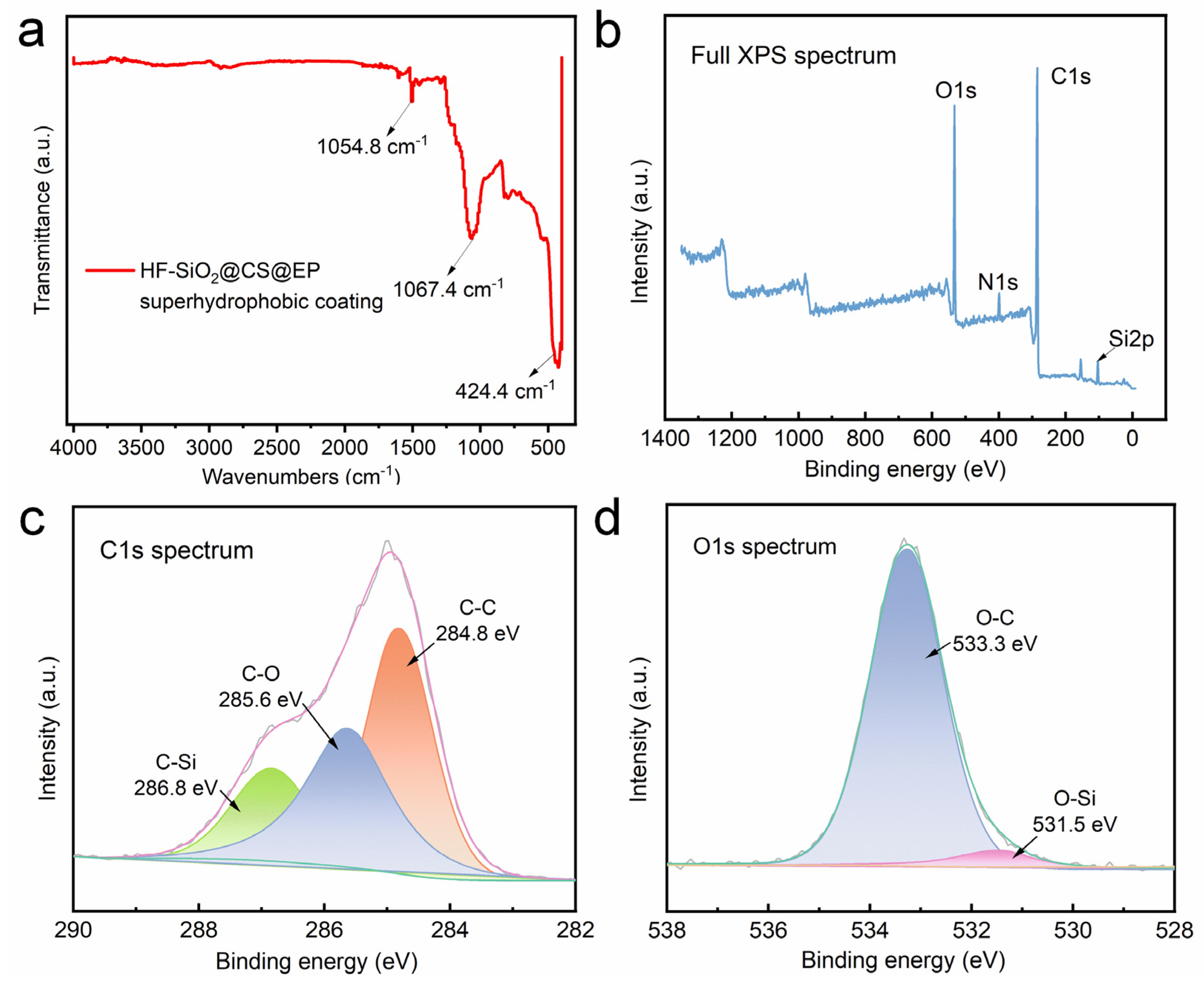
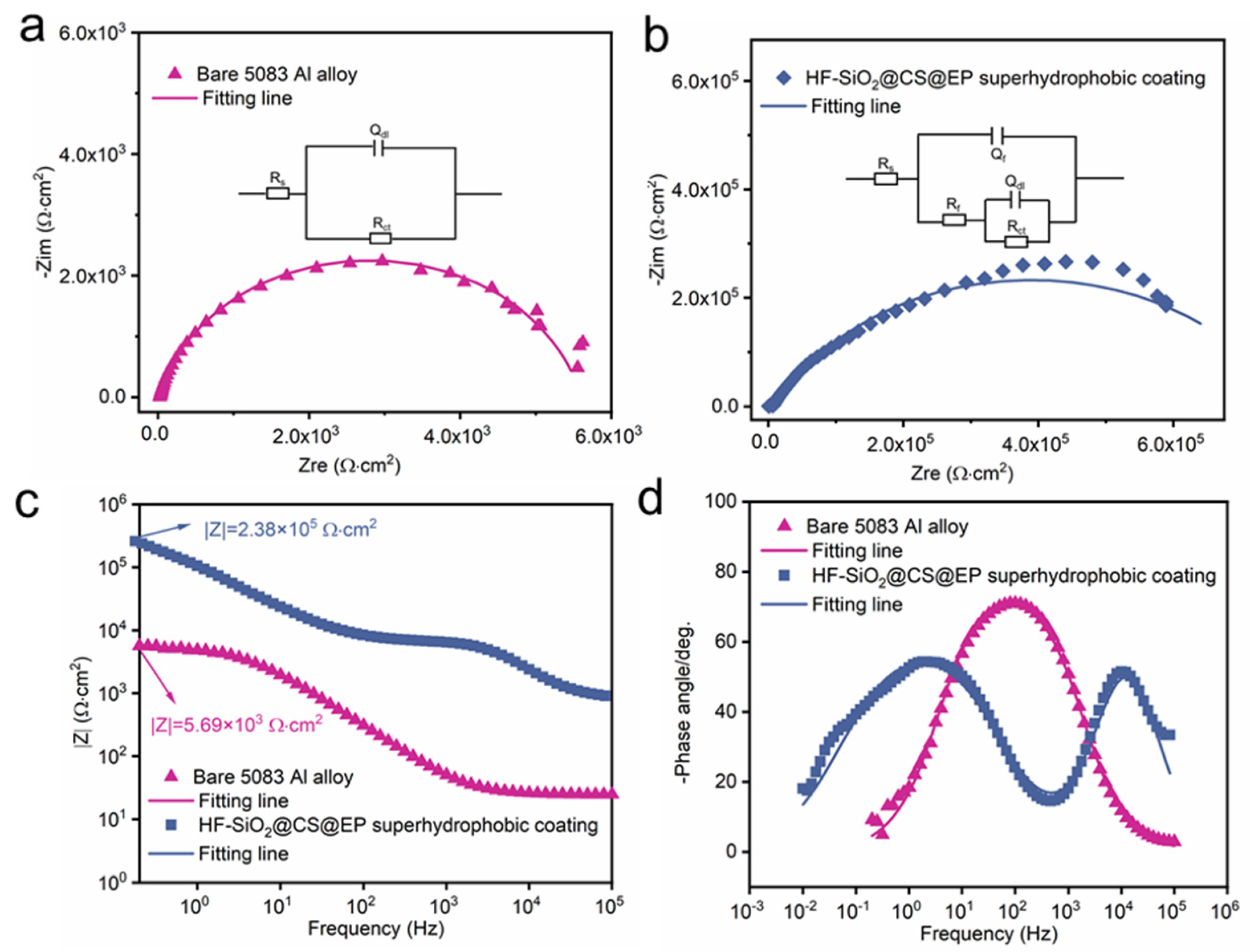

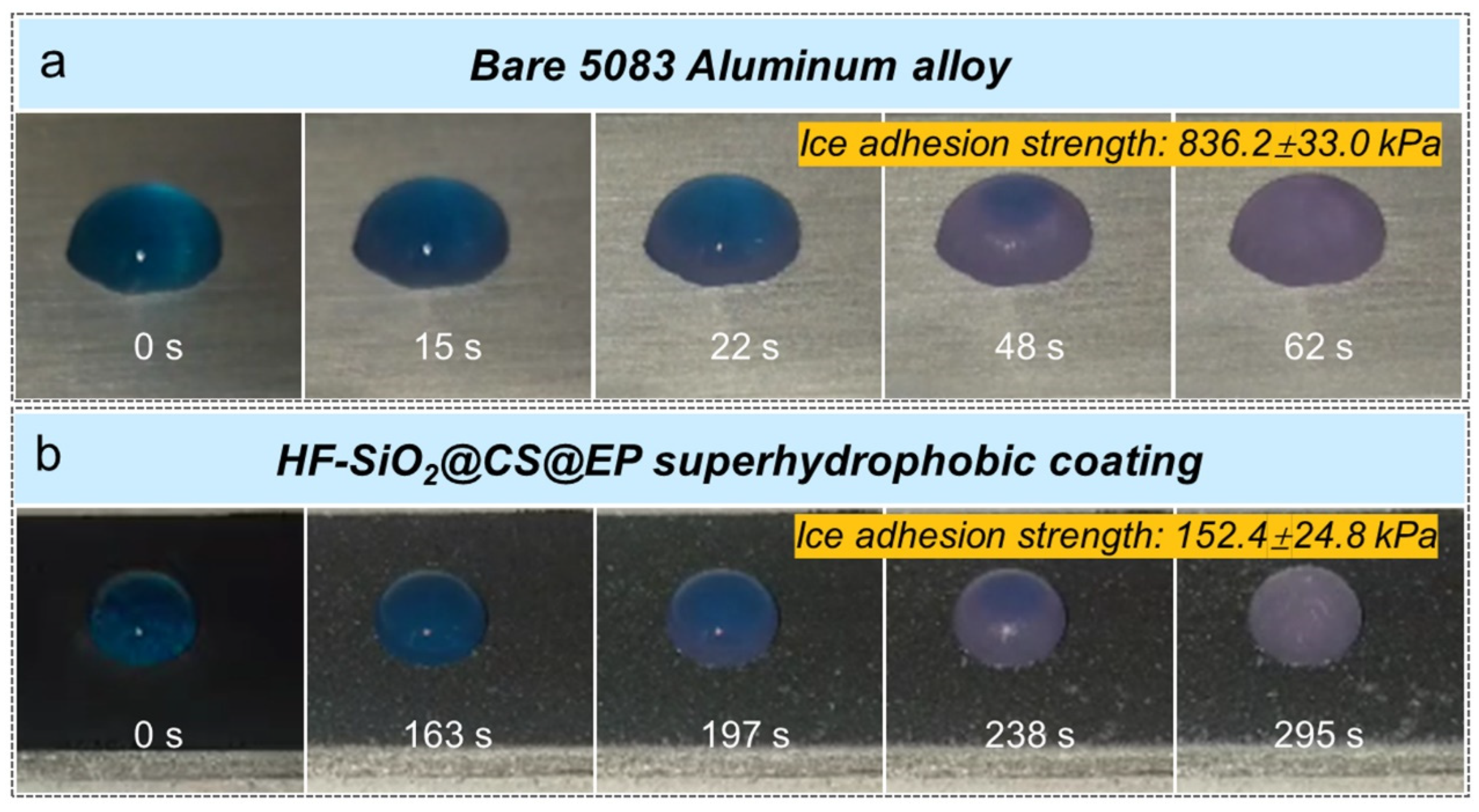
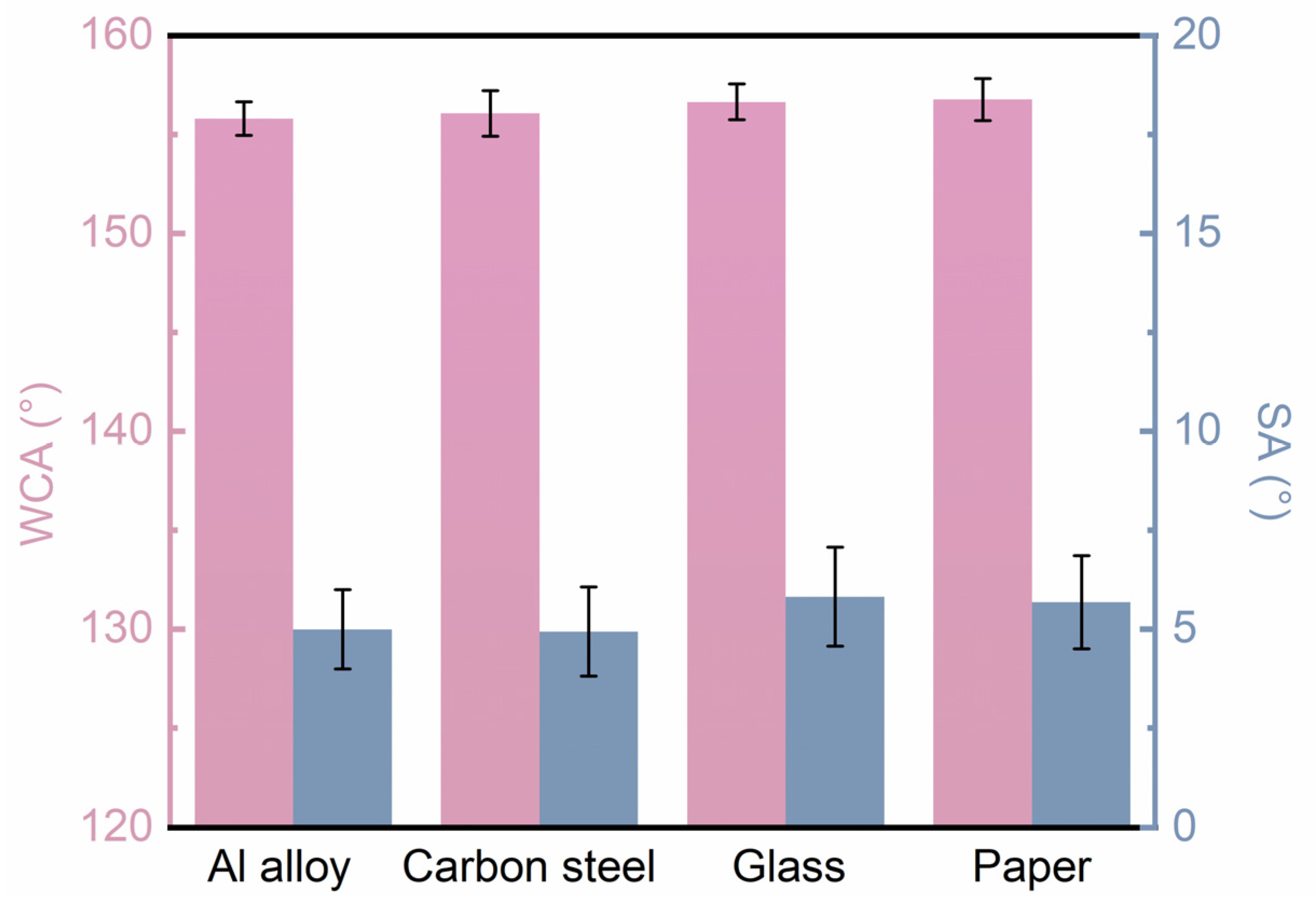
| Parameters | Bare 5083 Al Alloy | HF-SiO2@CS@EP Superhydrophobic Coating |
|---|---|---|
| RS (Ω·cm2) | 25.9 | 27.1 |
| Qf (Ω−1·cm−2·sn1) | / | 1.11 × 10−8 |
| n1 | / | 0.95 |
| Rf (Ω·cm2) | / | 5.70 × 103 |
| Qdl (Ω−1·cm−2·sn2) | 1.30 × 10−5 | 2.78 × 10−6 |
| n2 | 0.86 | 0.70 |
| Rct (Ω·cm2) | 6.05 × 103 | 7.66 × 105 |
Disclaimer/Publisher’s Note: The statements, opinions and data contained in all publications are solely those of the individual author(s) and contributor(s) and not of MDPI and/or the editor(s). MDPI and/or the editor(s) disclaim responsibility for any injury to people or property resulting from any ideas, methods, instructions or products referred to in the content. |
© 2024 by the authors. Licensee MDPI, Basel, Switzerland. This article is an open access article distributed under the terms and conditions of the Creative Commons Attribution (CC BY) license (https://creativecommons.org/licenses/by/4.0/).
Share and Cite
Zhang, B.; Zhao, L.; Hou, B. Easily Applicable Superhydrophobic Composite Coating with Improved Corrosion Resistance and Delayed Icing Properties. Polymers 2024, 16, 2800. https://doi.org/10.3390/polym16192800
Zhang B, Zhao L, Hou B. Easily Applicable Superhydrophobic Composite Coating with Improved Corrosion Resistance and Delayed Icing Properties. Polymers. 2024; 16(19):2800. https://doi.org/10.3390/polym16192800
Chicago/Turabian StyleZhang, Binbin, Lixia Zhao, and Baorong Hou. 2024. "Easily Applicable Superhydrophobic Composite Coating with Improved Corrosion Resistance and Delayed Icing Properties" Polymers 16, no. 19: 2800. https://doi.org/10.3390/polym16192800
APA StyleZhang, B., Zhao, L., & Hou, B. (2024). Easily Applicable Superhydrophobic Composite Coating with Improved Corrosion Resistance and Delayed Icing Properties. Polymers, 16(19), 2800. https://doi.org/10.3390/polym16192800








